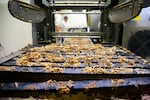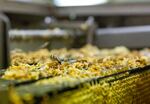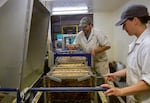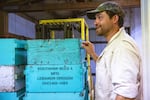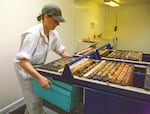The third episode of OPB’s video series on food and food systems in the Pacific Northwest, “Superabundant,” explores the world of Oregon honey.
The matchmaker
For Lee Hedgmon, life is sweet. She’s a master brewer and founder of The Barreled Bee, where she sells her barrel-aged honey creations.
“Honey, for me, has always been a snapshot of place and time. It’s like rings on a tree,” Hedgmon said. “It is literally a moment or a segment of chunks of time that it took the bees to pollinate, harvest, create all this honey. And it’s amber in an edible form.”
There’s an art to successfully combining the flavors of spirits and honey — both can have an exceptional range of flavor, and they don’t always gel. Hedgmon says creating the perfect pair feels a little like trying to matchmake people.
“‘Is this the perfect couple?’ Or am I going to see them in six months and be like, ‘Yeah, we just decided to be friends,’” she said.
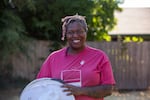
Lee Hedgmon, the founder of The Barreled Bee, produces handcrafted, small-batch, barrel-aged honey. Hedgmon installed a beehive in her backyard in northeast Portland, Oregon, to learn more about beekeeping.
Hanin Najjar / OPB
Essentially, she takes her honey and ages it in barrels previously used to age spirits, like wine or whiskey. It marries the two flavors, creating something entirely new.
“Barrels, they have their own kind of tricks and whatnot,” Hedgmon explained. “You can have this exact same barrel, and I’ve done this where I’ve had two very, very distinctive barrels. I’ve emptied them on the very same day and I’ll smell them and I’ll taste, and they taste very different.”
Honey is similar in that way.
“You can go and have honey here and you move five miles east, west, north, south, and it’s going to be a completely different terroir,” Hedgmon said. For the uninitiated, terroir describes the characteristic taste and flavor imparted to a wine by the environment in which it is produced.
Hedgmon sounds like a sommelier when she discusses these complex flavors, and that’s no surprise, considering she got into the business initially by creating fermented beverages — beer, wine, cider and mead — before turning to honey.
“I took up beekeeping because I wanted to be more informed. And the more I learned, the more I grew to love keeping bees,” she said.
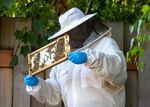
Hedgmon inspects the honey in a honeycomb frame from her backyard beehive in Northeast Portland, July 19, 2021. Hedgmon, the founder of The Barreled Bee, produces handcrafted, small-batch, barrel-aged honey.
Hanin Najjar / OPB
The bee’s knees
Since the first domestic beehives in ancient Egypt, humans have been working alongside bees to cultivate the honey we love so much.
“They’re what we like to call florivores,” Emily Parker said. She’s a pollination consultant at Bee & Bloom, an apiary on Sauvie Island just outside of Portland that specializes in helping people with their hives.
“Bees are getting all their food from flower sources. They’re getting their carbohydrates from that nectar, and they’re getting their protein from that pollen resource,” she said.
Bees aren’t the only creatures helping to pollinate the flowers — there are also beetles, hummingbirds, butterflies and more — but they are the only ones that take the nectar home and turn it into honey.
In fact, there are even bees in our area that pollinate but don’t make honey, like mason bees and bumblebees.
“It’s a very altruistic society that they live in, where it’s all for the greater good of the next generation of bees coming out, and for the survivability of the colony as a whole that they’re not necessarily going to see,” Parker said.

Honey drips from the extractor at the Southpaw Bees facility in Lebanon, Oregon, July 15, 2021.
Hanin Najjar / OPB
Honey is extremely stable and can sustain a hive over the winter, long after the flowers have all died and the hive has settled in for hibernation.
A single bee will only live to make an eighth of a teaspoon of honey in its lifetime of a few weeks. It takes all the bees working together to create a hive that can last through the winter months.
The flavor of honey changes fairly drastically depending on the flowers the hive makes it out of, a fact that your average honey consumer might miss, but it’s of the utmost importance to people like Hedgmon.
“People don’t realize that anything that can be pollinated can be made into honey,” Hedgmon said.
“So they think honey, and they think the bear, they think clover, which when your body gets used to something, it doesn’t taste its distinctiveness,” she said, referring to the iconic bear-shaped clover honey many are familiar with.
A wealth of flavor
Hedgmon’s creations are a far cry from the clover honey you can buy at any grocery store.
Her latest addition advertised on her website is called Batch 107, a vetch honey aged in Abbey Creek winery’s Pinot Gris port barrel — vetch being an herbaceous plant of the pea family.
“The port gives notes of fresh peach, pineapple and almonds and the vetch honey, with its herbaceous vibrant green leaf flavor are a potent combination,” the website describes.
One of Hedgmon’s favorite flavor pairings comes from aging pumpkin blossom honey in a bourbon barrel.
“That had so much caramel characteristic to it that it tasted almost like when you’re roasting butternut or acorn squash and you put a little bit of brown sugar on the top of it and some butter. So it has that kind of creamy, silky sweet kind of spiciness to it,” she said.
Listen to brewer-turned-beekeper Lee Hedgmon discuss barrel-aged honey and breaking barriers by pushing play, below:
Oregon produces almost 3 million pounds of honey each year, a bit less than Washington and Idaho. Taken together, the three states produce about a fourth of the honey of the biggest producer: North Dakota. But it’s not always about being the biggest.
“Oregon honey is special because there’s so many great varieties that come from this state,” said Alan Turanski, president and beekeeper at GloryBee. GloryBee is family owned and operated and based in Eugene, Oregon. “It’s a very diverse agricultural state and there is a wide variety of crops,” he said.
To appreciate the nuances in honey is to appreciate the diverse ecosystem of plants in a region.
Hedgmon offers honey-tasting classes, in which she teaches people how to discern all the different flavors within the honey they sample.
“There’s light green, there’s lime green, there’s chartreuse, there’s summer grass green, but then there’s late summer grass green, which can look a little different. And so when you talk about these things, it’s not just green. And when we’re talking about honey, it’s not just sweet,” she said.
“Have you peeled back all the layers? Have you gotten to every depth? And chances are we probably haven’t, which means there’s probably more to go. So keep tasting until you can find something different.”
Related: Watch all episodes of "Superabundant" here

Aud Koch

